Long Island is a region abundant in birdlife. Every year, thousands of birds of different species migrate to Long Island from different parts of the world.
Some of the birds stay in Long Island, while others stop on their way to other destinations. Long Island serves as a bird haven, thanks to its diverse habitats, including forests, beaches, wetlands, and fields.
These habitats offer food, shelter, and nesting sites for the various bird populations. From bald eagles to ospreys, Long Island is home to some of the most fascinating bird species in the world.
This article will explore the unique birdlife found in Long Island, highlighting some of the most notable species that reside in this region.
1. Downy Woodpecker
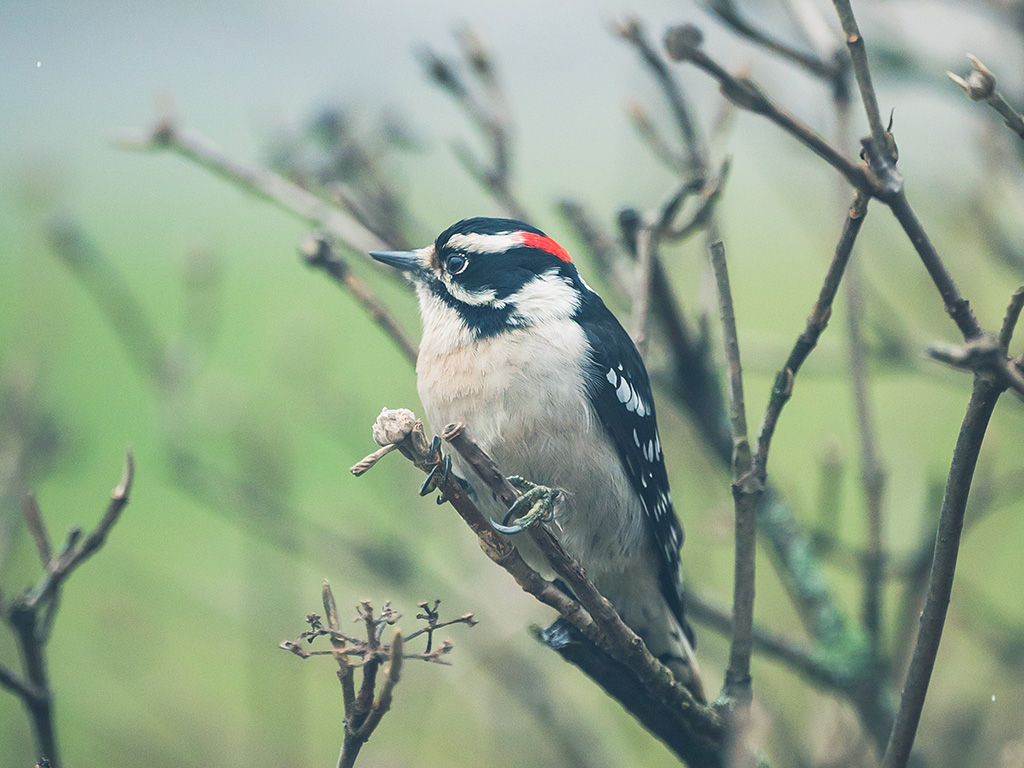
The downy woodpecker is a small species of woodpecker found in North America. Growing up to 7 inches long, it can be identified by its white belly and spotted wings.
It inhabits forests throughout the United States and Canada, with the exception of deserts in the southwest and northern tundra.
This bird nests in tree cavities and feeds mostly on insects but will supplement its diet with fruit or nuts when available.
The Downy Woodpecker has an unmistakable call that sounds like a loud ‘pik-er’, similar to other members of its family such as the Hairy Woodpecker.
Scientific classification:
| Kingdom | Animalia |
| Phylum | Chordata |
| Class | Aves |
| Order | Piciformes |
| Family | Picidae |
| Genus | Dryobates |
| Species | D. pubescens |
Also Featured In: Most Common United States Birds, Most Common Winter Birds
2. Red-Bellied Woodpecker
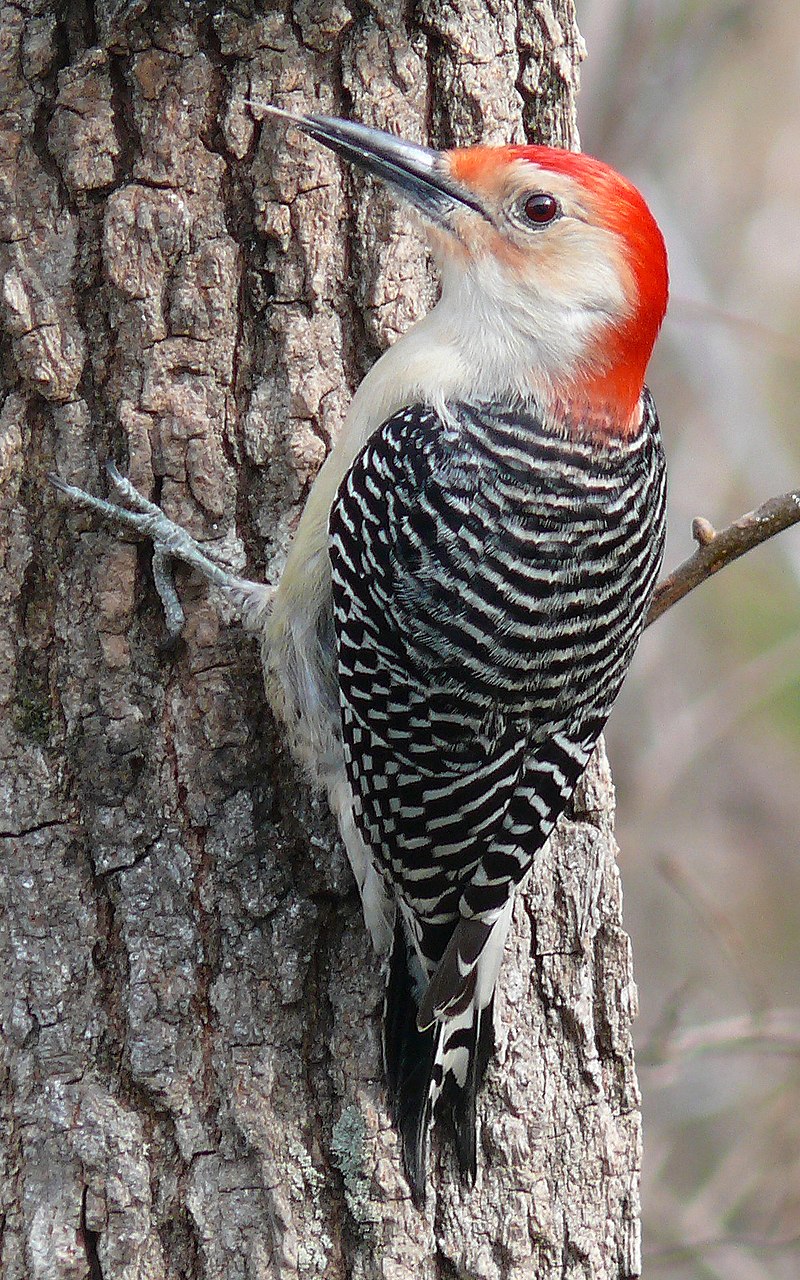
The Red-bellied woodpecker is a beautiful bird with an orange-red crown and nape. It breeds mainly in the eastern United States, ranging from Florida to Canada.
This medium-sized woodpecker of the family Picidae has black wings, white stripes on its back and tail feathers that are barred with black.
Its underside is mostly pale yellow or white but it also features some red coloration around its neck area.
Despite this subtle red hue, it should not be mistaken for the entirely red head and neck belonging to the Red-headed woodpecker of the same genus Melanerpes carolinus.
The Red bellied Woodpeckers diet consists primarily of insects such as ants, beetles and grasshoppers along with nuts fruits berries and tree sap which they will feed upon during different times throughout their life cycle.
Scientific classification:
| Kingdom | Animalia |
| Phylum | Chordata |
| Class | Aves |
| Order | Piciformes |
| Family | Picidae |
| Genus | Melanerpes |
| Species | M. carolinus |
Also Featured In: Birds Live in Arkansas, New Hampshire Birds You Should Know
3. American Coot
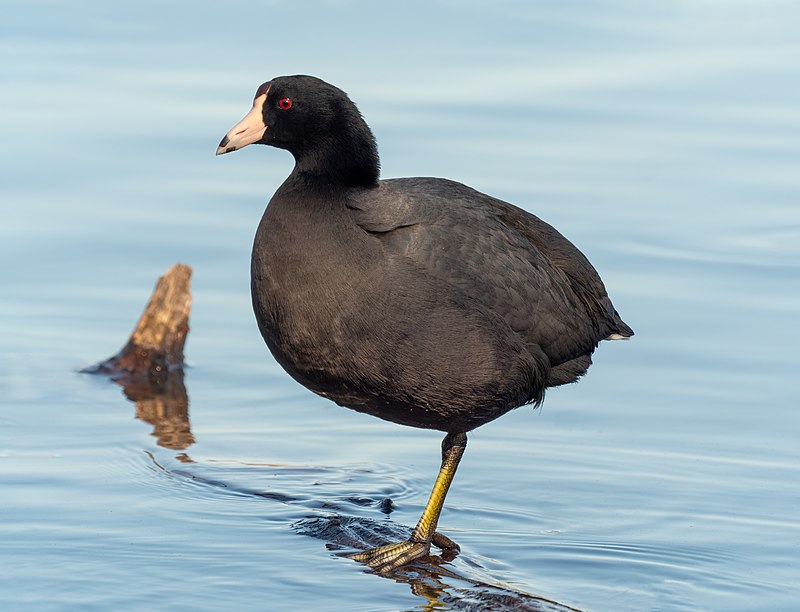
The American coot is a bird of the Rallidae family, commonly mistaken for ducks. However, they are only distantly related and have broad lobed scales on their lower legs and toes that fold back with each step to help them walk on dry land unlike ducks which have webbed feet.
Coots are omnivores who typically live in freshwater marshes, ponds and lakes but can also be found in brackish water habitats or even open oceans during migration season.
They feed mainly on algae and aquatic plants as well as small fish, snails, insects larvae and worms from time to time.
The males display territorial behaviour by chasing away intruders within their territory while females lay eggs mostly.
In floating nests made of vegetation near shorelines or islands among reeds where chicks hatch after about three weeks incubation period before swimming off into adulthood shortly afterwards at 10-12 weeks old.
Scientific classification:
| Kingdom | Animalia |
| Phylum | Chordata |
| Class | Aves |
| Order | Gruiformes |
| Family | Rallidae |
| Genus | Fulica |
| Species | F. americana |
Also Featured In: Most Popular Bird Species in North America, Phoenix Birds You Should Know
4. Belted Kingfisher
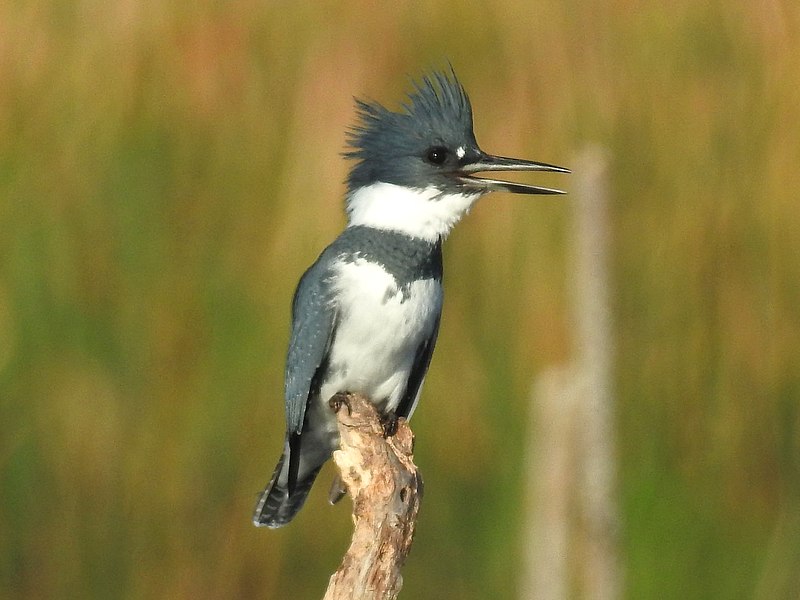
The belted kingfisher is a large, eye-catching bird native to North America. It belongs to the family Alcedinidae and has been divided into three subfamilies by recent research.
The species was first described in 1758 by Carl Linnaeus in his Systema Naturae.
This water Kingfisher stands out for its size as well as its striking plumage; males are bright blue on top with white below and females have rusty brown backs and wings with a thick black breast band across their chest.
They also possess an impressive call which can be heard from quite far away.
Belted kingfishers feed mainly on small fish but will sometimes also eat crustaceans, insects or even amphibians if they come across them while hunting around rivers or streams.
All in all, this is truly one remarkable bird that deserves our admiration.
Scientific classification:
| Kingdom | Animalia |
| Phylum | Chordata |
| Class | Aves |
| Order | Coraciiformes |
| Family | Alcedinidae |
| Subfamily | Cerylinae |
| Genus | Megaceryle |
| Species | M. alcyon |
Also Featured In: Blue Birds You’ll Found around Us, Common Southern Californian Birds
5. Cyanocitta
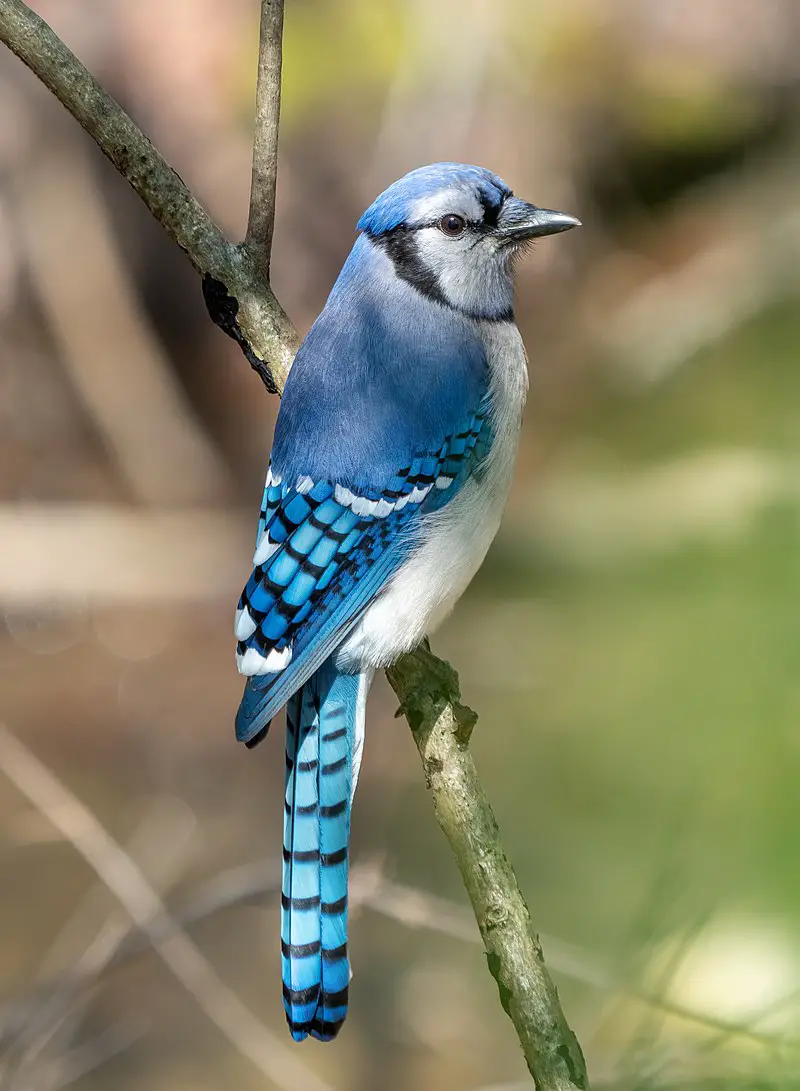
Cyanocitta is a genus of birds belonging to the Corvidae family, which includes crows, jays and magpies. It was established in 1845 by Hugh Edwin Strickland and consists of four species: Steller’s Jay, Blue Jay, Clark’s Nutcracker and Gray Jay.
The name Cyanocitta comes from two Greek words – kuanos meaning “dark blue” and kitta meaning “jay” – which perfectly describes these colourful birds with their bright feathers that range from deep blues to light grays.
They are also known for being very intelligent animals as they can solve complex problems such as opening boxes or finding food hidden under rocks.
As well as this impressive ability, Cyanocittas have been known to mimic human voices.
Scientific classification:
| Kingdom | Animalia |
| Phylum | Chordata |
| Class | Aves |
| Order | Passeriformes |
| Family | Corvidae |
| Genus | Cyanocitta Strickland, 1845 |
Also Featured In: Common Birds in Canada, Birds of Symbolism
6. Pileated Woodpecker
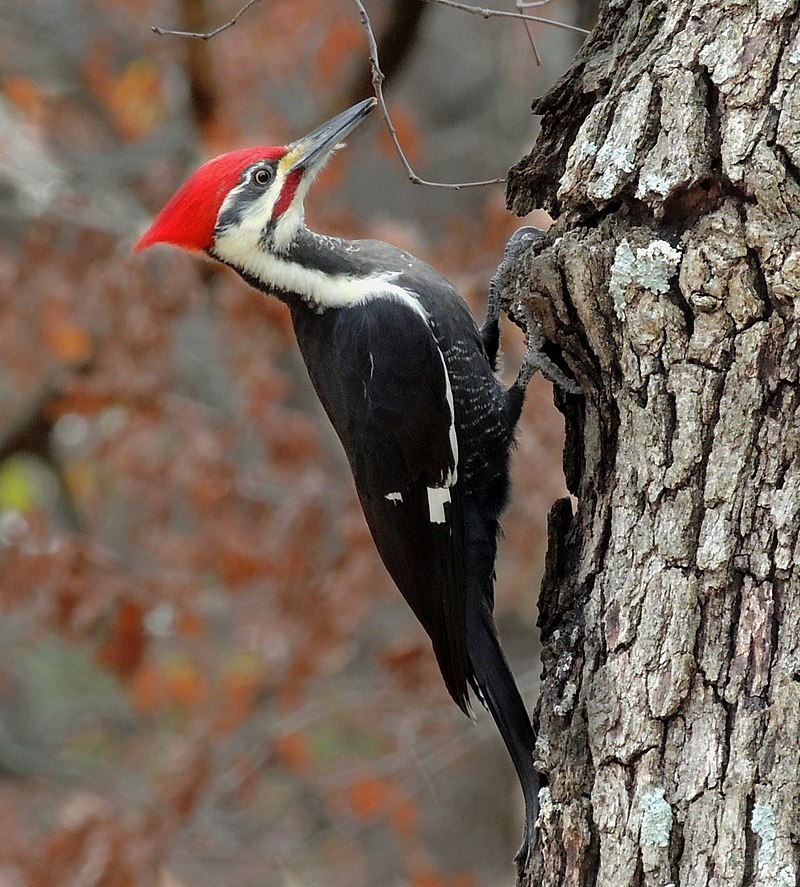
The pileated woodpecker is a large, majestic bird native to North America.
Its striking black plumage and red crest make it an unmistakeable sight in the forest canopy of deciduous forests across eastern North America, Great Lakes region, Canada’s boreal forests, and parts of the Pacific Coast.
It is one of the largest woodpeckers in North America: larger than any other confirmed species except for perhaps its relative; the ivory-billed woodpecker.
Insectivorous by nature, this stunning creature can be seen pecking away at tree trunks searching for food or making nest cavities – all with remarkable skill.
The pileated woodpecker truly stands out as a symbol of beauty and resilience amongst our avian wildlife.
Scientific classification:
| Kingdom | Animalia |
| Phylum | Chordata |
| Class | Aves |
| Order | Piciformes |
| Family | Picidae |
| Genus | Dryocopus |
| Species | D. pileatus |
Also Featured In: Summer Birds that Live around Us, British Columbian Birds
7. Piping Plover
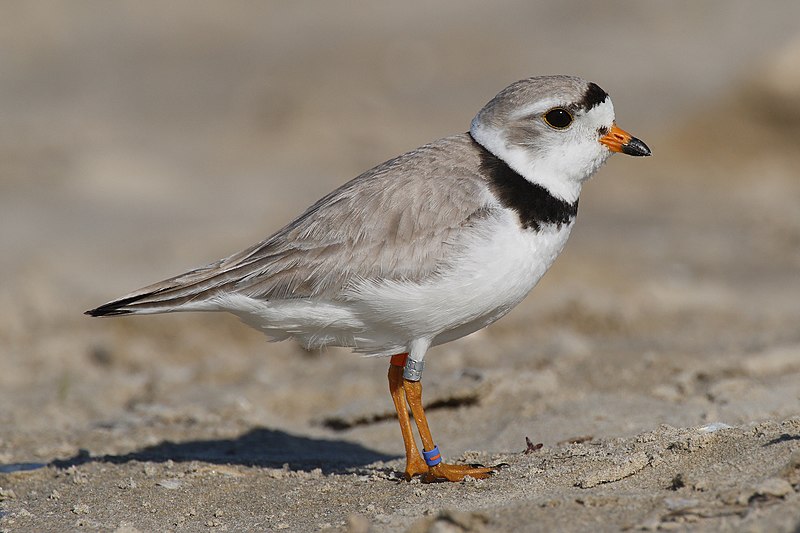
The Piping Plover is a small shorebird that can be found along sandy or gravel beaches in North America.
It has yellow-orange-red legs and its distinctive features include a black band across the forehead from eye to eye, as well as a thicker chest band for males during breeding season.
They are threatened by human activity on their habitats such as increasing development of coastal areas, destruction of their nesting sites due to recreation activities like beach driving and off-leash dogs.
Conservation efforts aim at protecting these birds through habitat protection measures including fencing off areas where they nest and restricting access during breeding seasons.
The future looks brighter with conservation initiatives by local governments slowly bringing the population up again over time.
Scientific classification:
| Kingdom | Animalia |
| Phylum | Chordata |
| Class | Aves |
| Order | Charadriiformes |
| Family | Charadriidae |
| Genus | Charadrius |
| Species | C. melodus |
Also Featured In: Birds of Nova Scotia, Large Birds of Michigan
8. Red-Headed Woodpecker
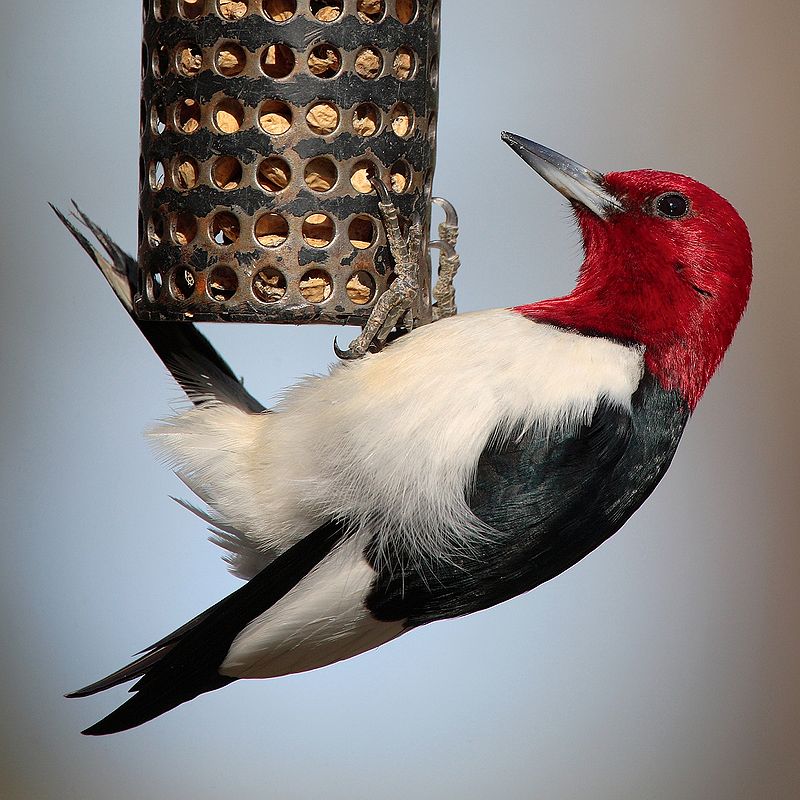
The red-headed woodpecker is a mid-sized bird found in temperate North America. It has striking plumage, with its head and neck being bright red while the rest of its body is primarily black and white.
Its wings are rounder than other similar species, allowing it to maneuver through tight spaces easily when searching for food or shelter.
The breeding habitat of this bird consists mainly of open fields across Canada and the east-central United States.
Despite facing threats such as deforestation, urbanization, predation from larger birds, collisions with windows or cars due to their inquisitive nature.
These birds remain listed on IUCN’s Red List as least concern thanks largely in part to conservation efforts by local governments and organizations dedicated to protecting wildlife habitats.
Scientific classification:
| Kingdom | Animalia |
| Phylum | Chordata |
| Class | Aves |
| Order | Piciformes |
| Family | Picidae |
| Genus | Melanerpes |
| Species | M. erythrocephalus |
Also Featured In: Georgia Birds, Birds that Migrate through Illinois in the Spring
9. Eastern Screech Owl
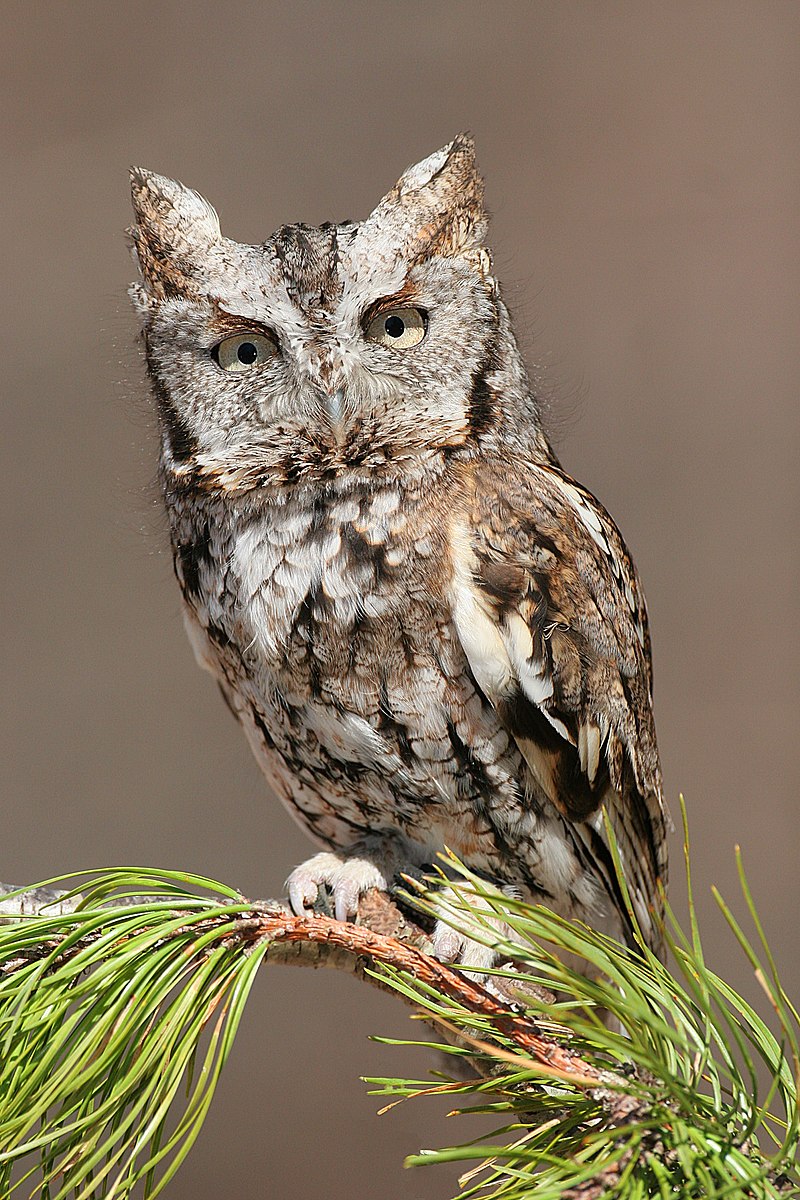
The Eastern screech owl is a small nocturnal bird native to most wooded areas in Mexico and Canada. It has adapted well to human development, making it relatively common in East North America.
This species is known for its unique call which often sounds like a horse whinnying or an electronic beep.
Its feathers are mainly grey with brown bars, but they can also range from red-brown to blackish-grey depending on the individual bird’s location.
They feed primarily on insects and other small animals such as mice and lizards that live near their nest sites at night.
The eastern screech owl is an amazing creature adapting well to humans while still managing to stay hidden under cover of darkness.
Scientific classification:
| Kingdom | Animalia |
| Phylum | Chordata |
| Class | Aves |
| Order | Strigiformes |
| Family | Strigidae |
| Genus | Megascops |
| Species | M. asio |
Also Featured In: Birds You’ll Find in Zoo, Common Birds of Houston
10. Clapper Rail
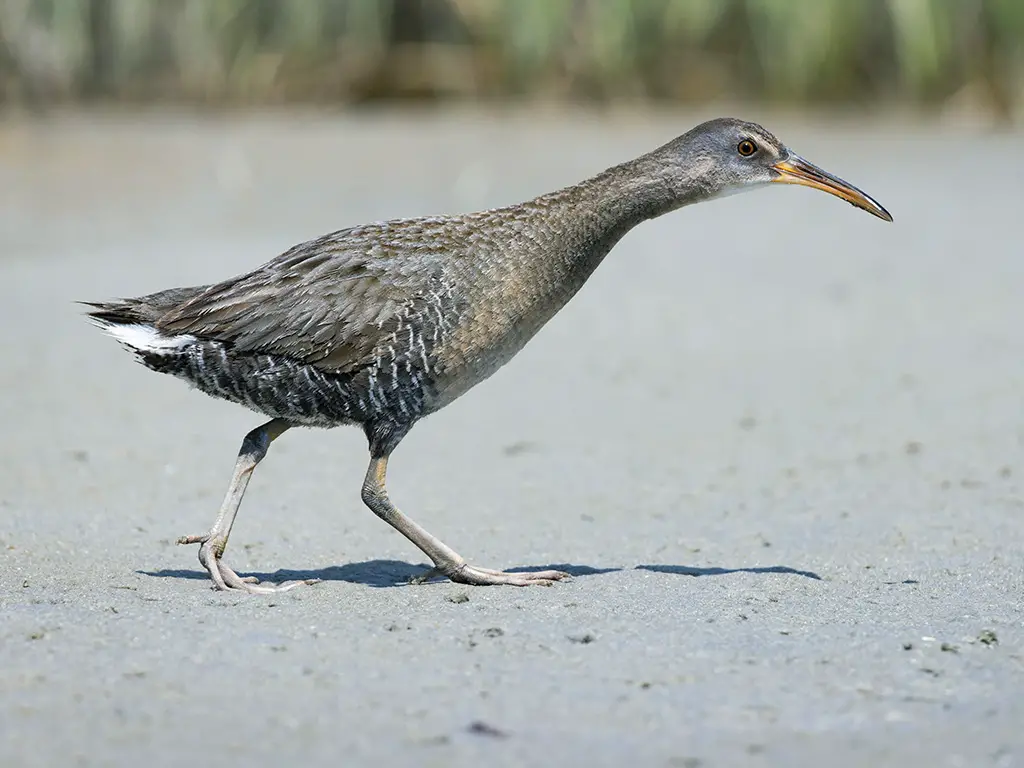
The Clapper Rail is a large, brown bird that belongs to the Rallidae family. It is found in wetlands along the eastern coast of America, Mexico and some Caribbean Islands.
This species was once considered to be related to Mangrove Rails but recent taxonomic studies have shown otherwise.
They are quite vocal with their loud calls which sound like someone clapping two stones together hence its name ‘Clapper’.
These birds feed on small crabs, fishes and insects in coastal marshes and swamps making them an important part of wetland ecosystems.
In order for these birds to thrive actions should be taken by governments such as restoring habitats or creating new ones so they can carry out their activities without any disturbance from humans or predators.
Scientific classification:
| Kingdom | Animalia |
| Phylum | Chordata |
| Class | Aves |
| Order | Gruiformes |
| Family | Rallidae |
| Genus | Rallus |
| Species | R. crepitans |
Also Featured In: Saint Kitts & Nevis birds, Birds You’ll Find in South Texas
11. Least Tern
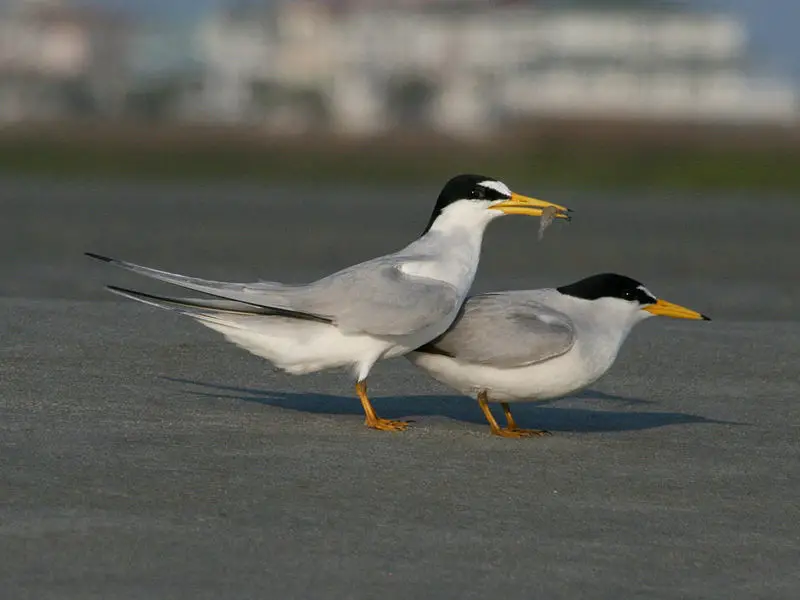
The Least Tern is a species of tern native to North America and northern South America. It has many close relatives, such as the yellow-billed tern and Peruvian tern from South America, or the little tern from the Old World.
The bird measures 8.7 – 9.4 inches in length with a wingspan of 16–18 inches acrosss, making it an intermediate size between most other species of birds within its family groupings.
Its feathers are usually gray on top with white underneath and typically have darker accents near their heads along with bright red bills for feeding during summer months when they mate upon beaches found throughout these regions mentioned above.
They feed mainly on small fish that live at shallow depths near shorelines where they also nest nearby due to migratory patterns which take place annually each year.
Hence why this particular bird does not travel far distances away from areas known as home for them over long periods of time like some other types do.
Scientific classification:
| Kingdom | Animalia |
| Phylum | Chordata |
| Class | Aves |
| Order | Charadriiformes |
| Family | Laridae |
| Genus | Sternula |
| Species | S. antillarum |
Also Featured In: Aruba birds, Most Common Birds in South America Birds
12. Common Gallinule
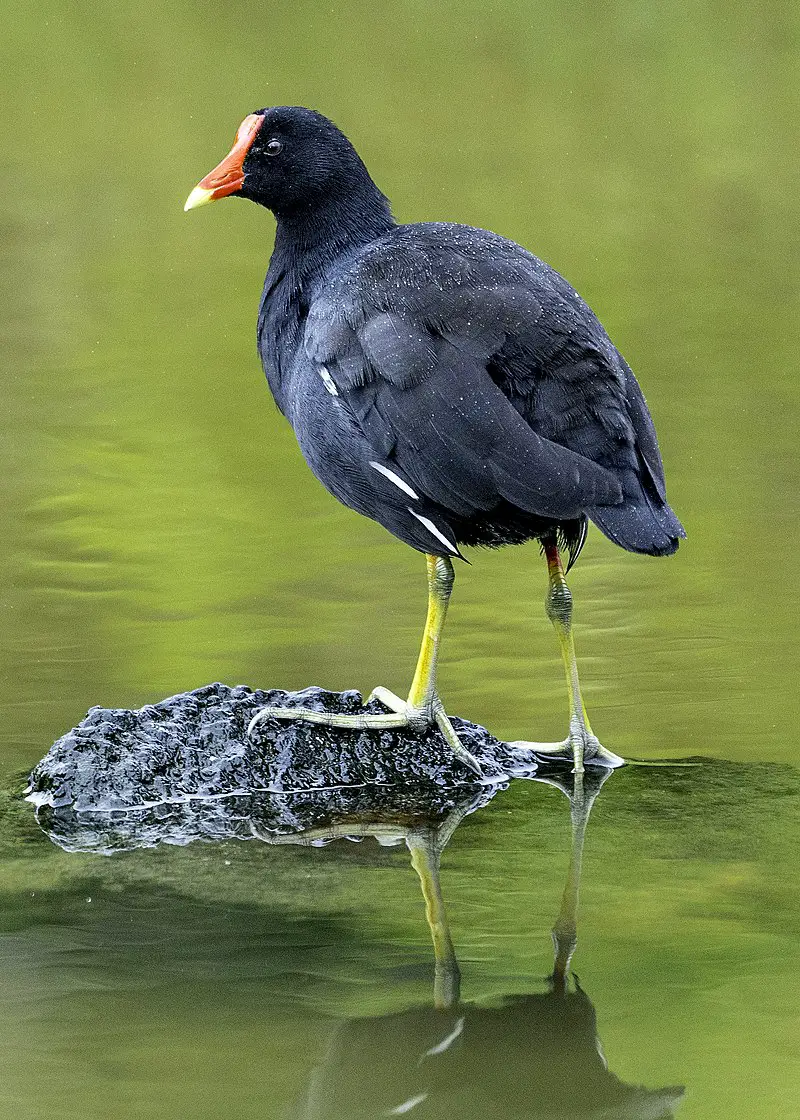
The Common Gallinule is a bird of the Rallidae family, native to parts of the Americas. It can be found in marshes, ponds and other wetland habitats which are well-vegetated.
This species prefers temperate climates and is not generally seen in polar regions or rainforests.
It has mainly greyish plumage with black wings and tail feathers, while its head has orange markings on either side along with an orange bill and yellow legs.
The underside usually appears white when flying but may have buffy undertones during breeding season.
Its diet consists primarily of aquatic vegetation as well as small invertebrates such as insects, snails or tadpoles; sometimes it will also take grains from fields nearby wetlands if available.
The Common Gallinule’s main call is a loud “kuk-kaa-kow” sound that can often be heard echoing across these areas where they reside.
Scientific classification:
| Kingdom | Animalia |
| Phylum | Chordata |
| Class | Aves |
| Order | Gruiformes |
| Family | Rallidae |
| Genus | Gallinula |
| Species | G. galeata |
Also Featured In: Bermuda birds, Swamps Birds You Should Know
13. Black-And-White Warbler
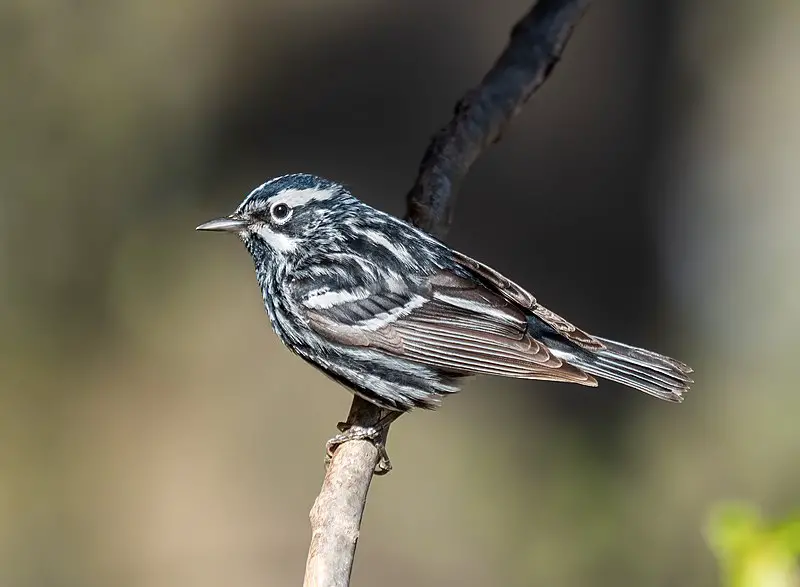
The Black-and-white Warbler is a unique species of bird native to North America. It has striking black and white plumage and breeds in the northern part of the continent, wintering in Central America, Florida, West Indies and Peru.
This warbler is rarely seen as far west as Europe but it’s still being studied for its behavior and ecology.
Its diet consists mainly of insects which it catches by clinging on trees like a woodpecker before quickly darting away again when prey appears.
The population size remains stable although they are vulnerable to habitat loss due to deforestation or other human activities so their conservation status should be monitored closely over time.
Scientific classification:
| Kingdom | Animalia |
| Phylum | Chordata |
| Class | Aves |
| Order | Passeriformes |
| Family | Parulidae |
| Genus | Mniotilta Vieillot, 1816 |
| Species | M. varia |
Also Featured In: Nuthatches Species, Birds that Live around Central Florida
14. Yellow-Bellied Sapsucker
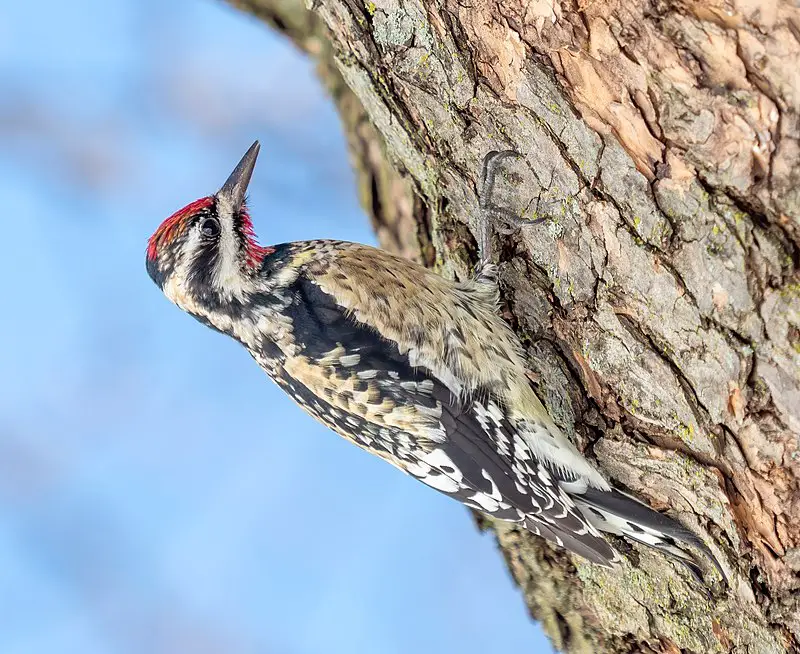
The Yellow-bellied Sapsucker is a medium sized woodpecker that can be found in Canada and the northeastern United States.
It was first described by English naturalist Mark Catesby who illustrated it with hand coloured plates for his book The Natural History of Carolina, Florida and the Bahama Islands during 1729 -1732.
This beautiful bird has white stripes on its black head which contrast against its yellow throat, breast and belly making it stand out from other birds. Its wings are barred with red patches adding to their beauty.
They also have white streaks on their sides along with bold spots at their back giving them an unique look among others.
Scientific classification:
| Kingdom | Animalia |
| Phylum | Chordata |
| Class | Aves |
| Order | Piciformes |
| Family | Picidae |
| Genus | Sphyrapicus |
| Species | S. varius |
Also Featured In: Woodpeckers Species, Black And White Birds You Don’t Know About
15. Northern Flicker
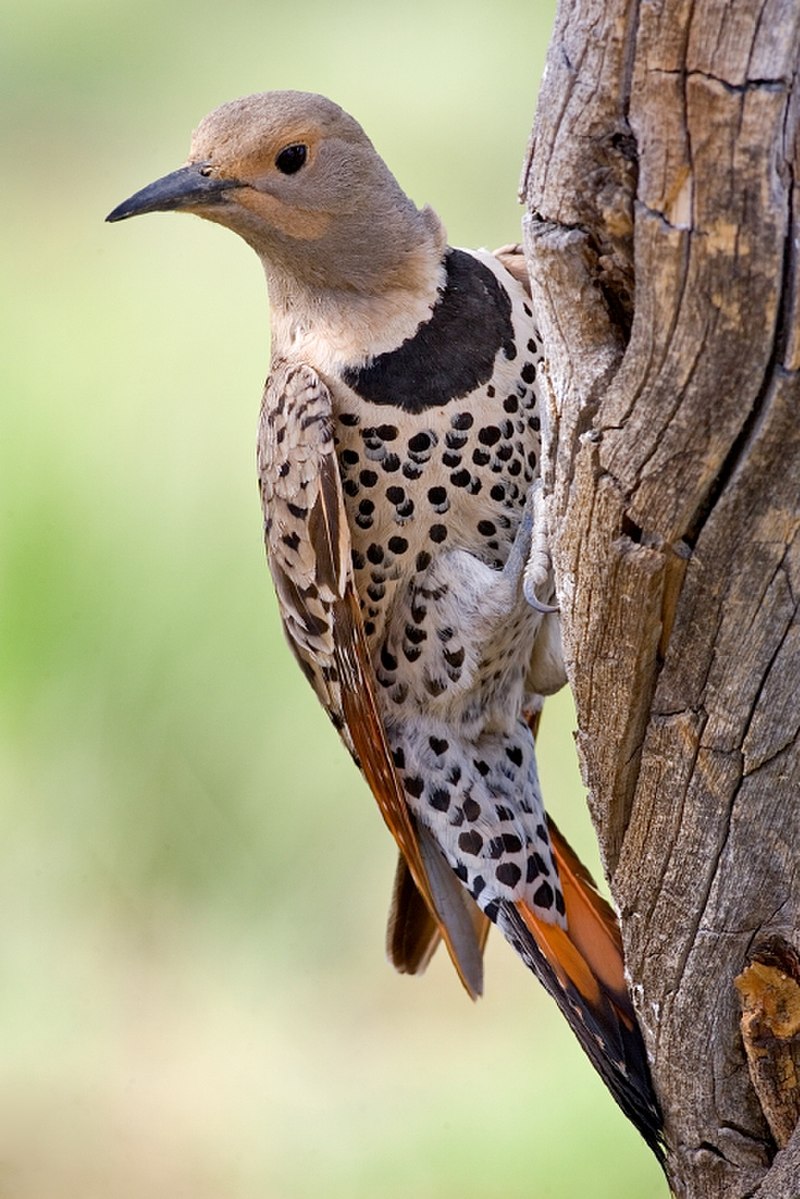
The Northern flicker is a woodpecker species found in North America, Central America, Cuba, and the Cayman Islands. This medium-sized bird is known for its unique migration behavior.
Over 100 common names are used to refer to the Northern flicker, one of them being “yellowhammer”. It is a beautiful bird with distinctive markings and a colorful plumage.
The Northern flicker is an important species in its ecosystem and plays a key role in maintaining a healthy balance in the environment.
Despite being a woodpecker, the Northern flicker has a diverse diet that includes insects, fruits, and seeds.
It is fascinating to observe this bird as it pecks at trees in search of food, communicates with its unique vocalizations and performs its incredible aerial displays.
The Northern flicker is truly a remarkable bird species that is worthy of our admiration and protection.
Scientific classification:
| Kingdom | Animalia |
| Phylum | Chordata |
| Class | Aves |
| Order | Piciformes |
| Family | Picidae |
| Genus | Colaptes |
| Species | C. auratus |
Also Featured In: Birds That Live in Colorado, Birds Commonly Found in New York
16. American Kestrel
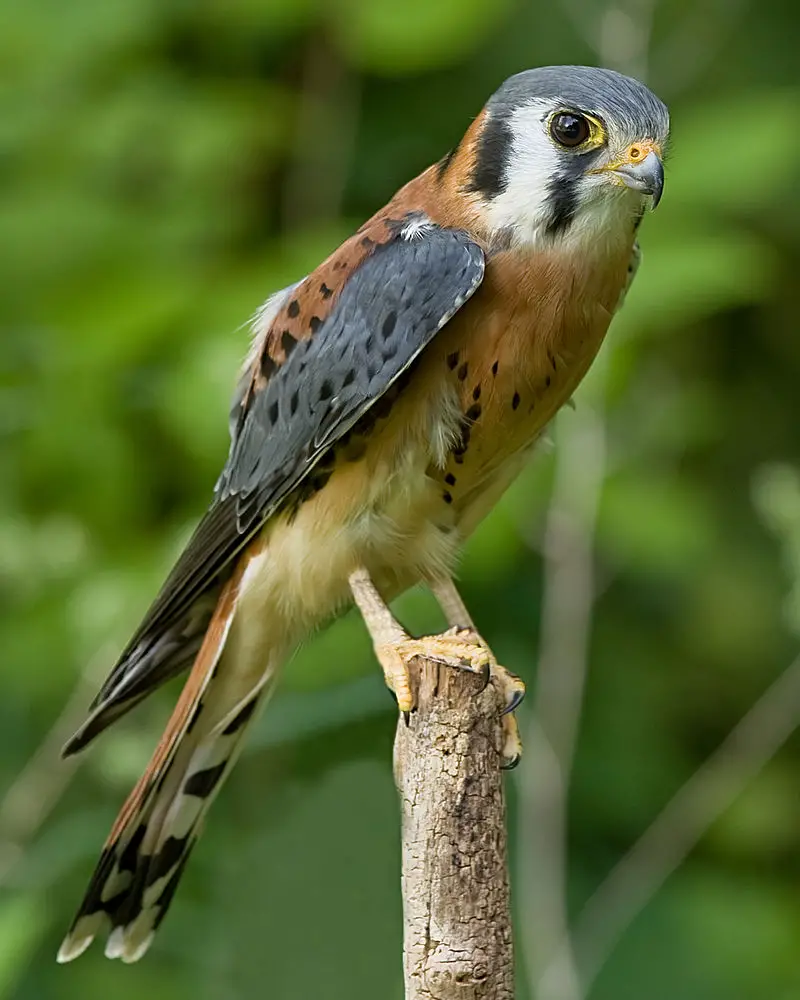
The American kestrel, also known as the sparrow hawk, is a popular falcon species in North America. It is the smallest falcon and can come in different sizes based on subspecies and sex.
Its weight ranges from that of a blue jay to a mourning dove. In addition to North America, this bird species is also found in South America.
There are 17 subspecies of American kestrels, each adapted to different environments.
Although small in size, the American kestrel is a fierce predator, often preying on insects, rodents, and other small birds.
Its impressive hunting skills and stunning coloration make it a favorite among birdwatchers and falconers alike.
Scientific classification:
| Kingdom | Animalia |
| Phylum | Chordata |
| Class | Aves |
| Order | Falconiformes |
| Family | Falconidae |
| Genus | Falco |
| Species | F. sparverius |
Also Featured In: Birds that Live in the Deserts, Birds that can be Seen in Outer Banks